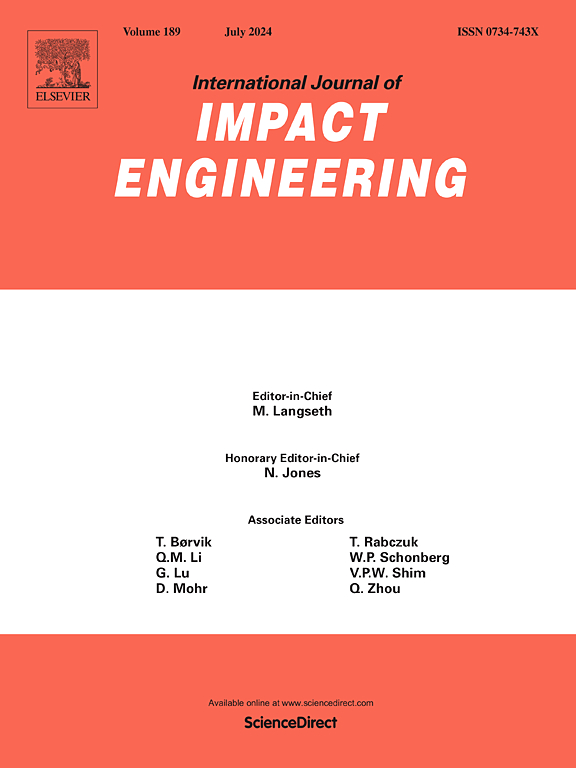增材制造和变形马氏体时效钢的抗弹道穿孔性能:实验和数值模型
IF 5.1
2区 工程技术
Q1 ENGINEERING, MECHANICAL
International Journal of Impact Engineering
Pub Date : 2025-02-27
DOI:10.1016/j.ijimpeng.2025.105271
引用次数: 0
摘要
将增材制造(AM)引入国防工业,为可定制和优化的轻型装甲创造了可能性。马氏体时效钢是一种低碳、高强度的钢,非常适合通过激光粉末床熔合(LPBF)制造增材制造,在热处理后具有超高强度,使其具有巨大的防护应用潜力。有希望的弹道性能已在文献中证明,尽管具有脆性行为的倾向;目前尚不清楚增材制造在多大程度上导致了延展性的不利降低。在弹道冲击下,AM马氏体时效钢目标与传统锻造目标的比较形成了本研究的主要目的。在打印状态和热处理状态下的AM马氏体时效钢已经在弹道范围内与传统锻造的对应物一起进行了实验表征,检查和测试。尽管在拉伸试验中发现延展性存在显著差异,但与热处理前后的锻造相比,AM马氏体时效钢的弹道极限速度差异很小。在大多数的弹道冲击试验中,增材制造目标的弹芯损伤比锻造目标更广泛。在动力求解器中建立数值模型,模拟非热处理材料的弹道冲击响应。标准和常用的材料模型被实施,只有简单的调整,以说明增材制造材料的特性。实验和数值计算的弹道极限速度在10%以内一致,数值结果是保守的。本文章由计算机程序翻译,如有差异,请以英文原文为准。
On the ballistic perforation resistance of additively manufactured and wrought maraging steel: Experiments and numerical models
The introduction of additive manufacturing (AM) to the defence industry has created possibilities for customisable and optimised light-weight armour. Maraging steel is a low carbon, high-strength steel, well suited to AM fabrication by laser powder-bed fusion (LPBF), that takes on ultra high-strength post heat-treatment, lending it significant potential for protective applications. Promising ballistic performance has been demonstrated in the literature albeit with a tendency for brittle behaviour; it remains unknown to what extent the AM processing is responsible for the unfavourable reduction in ductility. A comparison of AM maraging steel targets alongside traditionally wrought targets under ballistic impact forms the main objective of this study. AM maraging steel in both the as-printed and heat-treated state has been experimentally characterised, examined, and tested in a ballistic range alongside its traditionally wrought counterpart. Very little difference was found in the ballistic limit velocity of the AM maraging steel compared to wrought both before and after heat treatment, despite significant differences in ductility found in tensile tests. In the majority of the ballistic impact tests, damage inflicted on the projectile core was more extensive for the AM targets than for the wrought. Numerical models were constructed in the IMPETUS Solver to simulate the ballistic impact response of the non-heat-treated material. Standard and commonly used material models were implemented, with only simple adjustments to account for the AM material characteristics. The experimentally and numerically determined ballistic limit velocity agreed to within 10%, and numerical results were found to be conservative.
求助全文
通过发布文献求助,成功后即可免费获取论文全文。
去求助
来源期刊

International Journal of Impact Engineering
工程技术-工程:机械
CiteScore
8.70
自引率
13.70%
发文量
241
审稿时长
52 days
期刊介绍:
The International Journal of Impact Engineering, established in 1983 publishes original research findings related to the response of structures, components and materials subjected to impact, blast and high-rate loading. Areas relevant to the journal encompass the following general topics and those associated with them:
-Behaviour and failure of structures and materials under impact and blast loading
-Systems for protection and absorption of impact and blast loading
-Terminal ballistics
-Dynamic behaviour and failure of materials including plasticity and fracture
-Stress waves
-Structural crashworthiness
-High-rate mechanical and forming processes
-Impact, blast and high-rate loading/measurement techniques and their applications
 求助内容:
求助内容: 应助结果提醒方式:
应助结果提醒方式:


